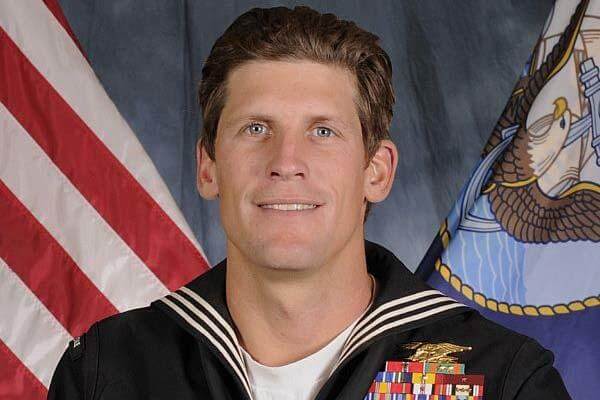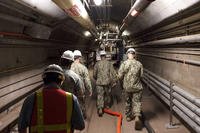Navy SEAL Charles Humphrey Keating IV was fatally wounded in a "gunfight" with ISIS attackers while coming to the rescue of other Americans who were trapped behind enemy lines in the assault.
"This was a gunfight, a dynamic gunfight. He got hit in the course of this battle," Army Col. Steve Warren said Wednesday of the close-up firefight with ISIS attackers north of Mosul.
"It was a bad day for us here yesterday," Warren said on behalf of the more than 4,000 U.S. troops in Iraqi, but the attack was eventually beaten back by furious U.S. airstrikes including B-52 bombers and A-10 ground attack aircraft, killing an estimated 58 enemy fighters.
However, fighting continued Wednesday where Keating fell in the small town called Tel Skuf by the Kurds, and Teleskof by the Iraqis, according to the Kurdish news agency Rudaw.
At least 12 fighters with the Islamic State in Iraq and Syria, or ISIS, remained in the town 14 miles north of Mosul when the main insurgent force, estimated at about 135, fled toward Mosul under the U.S. air attack.
"Their cell was broken up today, but one of them detonated his explosives, killing a Peshmerga officer," Muzafar Derki, a Peshmerga commander, told Rudaw. "Two other militants surrendered and the rest were killed in gun battles," he said.
In a video briefing from Baghdad to the Pentagon, Warren, a spokesman for Combined Joint Task Force-Operation Inherent Resolve, gave the following timeline and description of the battle for Tel Skuf:
A small team of U.S. military advisers -- Warren wouldn't say how many -- was in Tel Skuf for meetings with Kurdish Peshmerga commanders on the ongoing operations to seal off northern routes into Mosul as part of the long-term plan to retake the ISIS stronghold.
Keating was part of a Quick Reaction Force, or QRF, of fewer than 12 special operators who were not in the town but were on standby in case the advise and assist team needed help. Their primary mission then would be to evacuate the advisers and not to aid the Kurds in repelling the attack.
At about 5:30 a.m. local time , according to the Kurds, a force of more than 400 ISIS fighters, led by suicide truck bombers and bulldozers, broke through Peshmerga front lines, which Warren described as a series of lightly-armed checkpoints and observation posts. Their main objective appeared to be to take Tel Skuf, about 3.5 kilometers, or a little over two miles, behind the front lines.
At about 7:30 a.m. local time, ISIS fighters swarmed into Tel Skuf and twenty minutes later, the U.S. advise and assist team joined the Kurds in fighting back while calling on the QRF for help. Warren wouldn't say how or when the QRF arrived, but a commander of a Christian militia allied with the Kurds told The Washington Post that they came in four vehicles.
The ISIS fighters did not appear to know that Americans were in the town and they were not the target of the attack -- "there was no indication of that, no," Warren said.
At about 9:32 a.m., Keating was shot and mortally wounded in the firefight.
Warren said it was unclear whether Keating was hit by a sniper or by fire from a close-up enemy since "there were bullets everywhere. It was a big fight, one of the largest we've seen recently," he said.
Two UH-60 Black Hawk helicopters were called in for a medical evacuation and, in a sign of the intensity of the firefight, both were shot up as they lifted off but managed to reach a field hospital about 50 miles east in Irbil, the capital of the Kurdish Regional Government, where Keating died.
The medevac was carried out "within the ‘golden hour' but his wound was not survivable," Warren said.
As the firefight continued, the U.S. Joint Operations Center in Irbil mounted a major air assault, using aircraft on station and others that took off to join the attacks. Warren said the air assets included drones, F-15s, B-52s and A-10s.
Joint tactical air controllers in the operations center coordinated the airstrikes using video feeds from surveillance drones and guidance from Peshmerga fighters at the scene, Warren said.
In all, the U.S. aircraft carried out a total of 31 strikes, destroying a mortar system and a bulldozer and killing an estimated 58 enemy fighters, he said.
"He is an American hero," Warren said of the 31-year-old Keating, the grandson of the late Charles Keating, Jr., who served time in prison as a result of the 1980s savings and loan scandals.
The Pentagon has yet release the younger Keating's name officially, but he was identified Tuesday night by Arizona Republican Gov. Doug Ducey and Keating's relatives who live in Arizona, where Keating was a star distance runner at a Phoenix high school.
Keating had been an instructor at the SEAL base in Coronado, California, before deploying to Iraq earlier this year but he "felt called" to return to do what he could to stop the ISIS' atrocities, said another grandfather, Bill Holmes.
Holmes told The Wall Street Journal that his grandson, who was to be married this fall, joined the SEALS "because it was the hardest thing to do," and "he decided he wanted to go back" to Iraq.
Sen. John McCain, an Arizona Republican and chairman of the Senate Armed Services Committee, was one of five senators known as the "Keating Five" who were alleged to have intervened on behalf of Charles Keating Jr., in the savings and loans scandals. McCain was cleared of acting improperly but the Senate Ethics Committee said he had exercised "poor judgment" in his relations with Charles Keating, Jr.
In a statement, McCain mourned the death of Charles Keating IV.
"Like so many brave Americans who came before him, Charlie sacrificed his life in honorable service to our nation for a cause greater than self-interest, which we can never truly repay," McCain said in a statement.
"It is a combat death," Defense Secretary Ashton Carter said Tuesday of Keating's fatality, and it was the third in combat action for U.S. forces in Iraq.
The first U.S. combat death was that of Master Sgt. Joshua L. Wheeler, 39, of Sequoyah County, Oklahoma, who was killed last October while coming to the aid of Kurdish forces in a raid on an ISIS prison in northern Iraq that freed about 70 hostages.
In March, Staff Sgt. Louis F. Cardin, 27, of Temecula, California, and the 26th Marine Expeditionary Unit, was killed by ISIS rocket fire at a Marine fire base near Makhmour that was set up to support a staging area for Iraqi Security Forces gathering for a Mosul offensive.
The combat deaths have again called into question the Obama administration's strategy for Iraq and Syria in the campaign against ISIS which is intended to avoid "boots on the ground" combat while training, advising and assisting local forces and backing them up with airstrikes.
At his daily press briefing Tuesday, White House Press Secretary Josh Earnest defended the strategy while stressing that Keating' death was "a vivid reminder of the risks that our service members are taking."
"But the President has been clear, time and time again, exactly what their mission is," Earnest said. "That mission is to support Iraqi forces on the ground who are taking the fight to ISIL on the frontlines," he said, using another acronym for ISIS.
"Iraqi forces must fight for their own country," Earnest said. "United States forces cannot be a substitute for those Iraqi forces" to meet the overall goal of inflicting a lasting defeat upon ISIS, he said.
In Iraq, "our mission remains to advise, assist, train and equip our partner forces," and the U.S. has trained about 22,000 Iraqis since ISIS invaded in 2014 and backed them up with "devastating airpower," Warren said.
Of the more than 4,000 U.S. troops in Iraq, about several hundred are involved in the advise and assist teams that gr forward with local forces, Warren said. "It's a handful of teams that go in and advise and assist," he said. "Our intent is that they do not encounter the enemy. As we learned Tuesday, no plan is perfect."
-- Richard Sisk can Be reached at Richard.Sisk@Military.com.





























